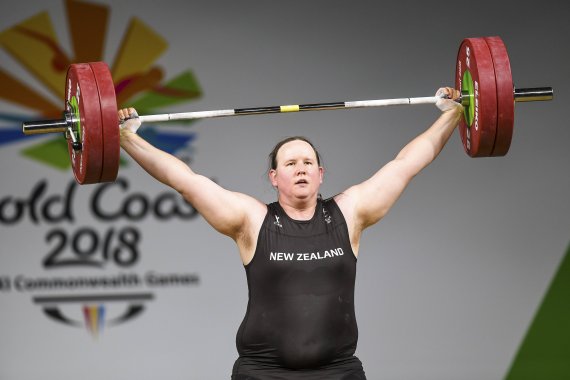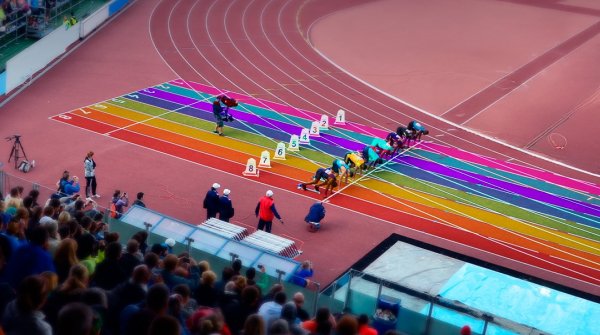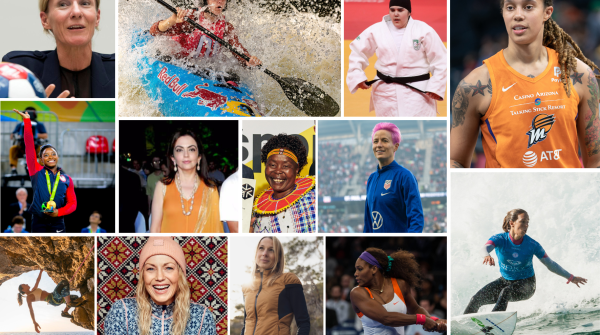Megan Rapinoe now has more than two million followers on Instagram. Why is that special? Because Megan Rapinoe is considered THE voice of the LGBTQ+ movement in professional sports. Almost every one of her social media posts reaches millions of people. In them, she engages in one way or another with the fight for social justice that Rapinoe, along with her wife Sue Bird, also a top athlete, is waging in U.S. society. And the fight is important: To date, for example, no active soccer player in the men's national league in Germany has come out. "Gay" is furthermore still used as an insult in many sports. It is meant to deny athletes their masculinity, which is associated with power and strength. But there are positive developments as well. In large part due to women like Megan Rapinoe and Sue Bird speaking out and thereby advancing LGBTQ+ rights and inclusion in sports.
Athletes who have come out themselves or see themselves as allies play an important role in the acceptance of LGBTQ+ in sports. On the one hand, they provide visibility, but they also give the topic a face and a story.
However, many athletes come out only after their careers have ended, because they still have to fear disadvantages. Some major sponsors, on whom professional athletes are usually dependent, may withdraw financial support for LGBTQ+ athletes for various reasons. Equally, there could be reprisals by the sports federation or the own state, such as the exclusion from tournaments despite sporting qualifications.
In America, NFL star Carl Nassib caused a stir with his coming out, currently playing for the Las Vegas Raiders. He followed national soccer player and activist Megan Rapinoe, who spoke out about her homosexuality back in 2012 and is known for her political commitment to the LGBTQ+ community. Nassib is the first active NFL player to come out about his homosexuality. This is notable because American football in particular is strongly associated with the patriarchal view of masculinity.
A prominent example in Germany is Thomas Hitzlsperger, who made it to the German national team as a soccer player. Shortly after his career ended, he confessed his homosexuality in a major newspaper interview in 2014. However, he always dismissed questions about the reasons for his late coming out - although the outing was very positively received by officials and fans. Since then, he has publicly campaigned for LGBTQ+ rights.
While for Hitzlsperger, Nassib and Rapinoe there was no professional regression, for Chinese national soccer player Li Ying her outing in 2021 was presumably the end of her career. In China, homosexuality is not explicitly banned, but is often socially associated with resentment. Ying was no longer called up to the national team and was not allowed to take part in the Tokyo Olympics, although this was not officially justified on the grounds of her sexuality.
Lia Thomas sparked an international controversy. The trans swimmer began competing in the women's category during her transition and achieved considerable success there. Conservative America in particular reacted harshly with debate and, in many places, far-reaching anti-LGBTQ+ laws. The IOC (International Olympic Committee) then deepened its efforts to re-regulate the grouping into tournament categories by gender.
Social media plays a major role for the LGBTQ+ community. On networks such as Instagram, TikTok or the Chinese platforms WeChat and Weibo, athletes can provide personal insights into their lives. And they position themselves: for example, by publicly showing their everyday life, reposting campaigns and important messages, or interacting with other accounts. In this way, they become tangible and identifiable figures for fans from the LGBTQ+ community. Young people from the queer community in particular feel close to them.
At the same time, this publicity is associated with negative experiences for many. Hate speech, insults, misanthropic comments and even concrete threats are daily experiences of prominent queer athletes. Add to this the equanimity or even incomprehension of many people outside the community who cannot understand why LGBTQ+ athletes* expose themselves to this negative energy.
Nevertheless, the outreach is invaluable to the queer community. Visibility and attention to LGBTQ+ rights are strengthened by large accounts. As a result, the issue reaches many people outside of the social bubble.
The first queer sports club in Europe was founded in Cologne in 1980: SC Janus. In 1982, the first Gay Games took place, which are based on the Olympic Games and aim to offer homosexual athletes a sports event without queer hostility. They take place every four years and are part of popular rather than professional sports, as no qualification is required to participate.
The number of queer sports clubs has been growing steadily since then. They want to create a safe space where LGBTQ+ athletes can pursue their sports without interference. Some clubs allow heterosexual people to participate as well, while others specialize in only single queer groups.
The visibility through a club and the team spirit among like-minded people are an important building block for many sports enthusiasts - also for the acceptance of non-heterosexuality. However, voices are repeatedly raised that see this as a delay of inclusive sport, in which sexuality should not play a role. The clubs usually counter this with the answer: Safe Spaces will exist as long as the sport makes them necessary.
Members of the LGBTQ+ community are still threatened by misanthropy, exclusion and insult in everyday life. They suffer sexual or sexualized violence and discrimination disproportionately more often. In 69 countries around the world, homosexuality is still punishable by law, and in seven of them same-sex sex is even punishable by death.
In public, it is therefore perceived as courageous to come out or to act as an ally. Because professional consequences are not uncommon. Not only the loss of sponsors, but also the denial of participation in competitions or the exclusion from teams. This is rightly feared by many queer athletes. In addition, depending on the sport or the prominence of the athletes, there may also be safety concerns.
Periodically, the issue of LGBTQ+ rights comes up when countries are involved that persecute queerness by law. One example was the Men's World Cup in Qatar - keyword: one-love-tie. The Gulf state, known for its queer hostility, required gay sports fans not to show their sexuality in public during the games. Even the rainbow flag was banned.
The way professional associations and sponsors deal with this issue is generally very different, partly because high investments and sponsorship money are associated with these competitions. And even among the athletes, the moral question of whether participation under these conditions is justifiable is controversial.
Since the Lia Thomas case, a fierce debate has raged around the question of whether trans women athletes can and should compete against cis women in competitions. The competition of trans men against cis men is much less of an issue due to the physical constitution.
The IOC is currently drafting new guidelines to address the complexity of the gender issue. Involved are many voices from science, but also considerable pressure from different currents within society.
Currently, a concept is under discussion according to which unverified and only apparent competitive advantages based on gender or physical differences should not lead to the exclusion of a female athlete. Thus, until scientifically based arguments prove otherwise, it is to be assumed that trans and inter female athletes do not have an unfair advantage. Both the LGBTQ+ community and academia welcome this right to self-determination and privacy.
Yet, for many, this concept ignores demonstrable, biological differences - such as the physical development of trans women when they do not begin transitioning pre-pubescently. These are often broader-shouldered and more muscular than cis women of comparable age due to a history of athleticism, but this is not completely equalized by hormone therapy. Similarly, there is no place for the question of whether inter women with higher testosterone levels than cis women have a competitive advantage in some sports.
Furthermore, the debate ignores the fact that for professional sports, it is rarely exclusively the muscle mass present that is decisive and that many other factors such as hand-eye coordination, fine motor skills or balance are of great importance. One of the ideas originally planned was therefore to have professional associations proactively research whether there are significant differences between cis men and women and trans men and women in their sport. Based on the results, a fair regulation should then be made specifically for that sport.
The World Rowing Federation then established testosterone guideline values for women's competition. In the case of inter athletes, an expert* panel decides on a case-by-case basis. However, the federation emphasizes that they only want to classify athletes and do not make any assessment of therapeutic measures.
The World Rugby Federation, on the other hand, now categorically excludes trans women from the women's class. It justifies this with safety concerns for the physical integrity of the participants.
A debate on trans men has not yet taken place and is not in the IOC's concept paper. So far, no professional association has commented on trans men having an advantage due to a smaller, lighter body.

Due to the visibility of LGBTQ+ athletes through their platforms, federations and involved companies are increasingly under pressure to position themselves. Likewise, bogus measures to improve inclusion - so-called pinkwashing - are denounced by those affected, thus enabling actual progress.The queer athletes* make the principle of empowerment clear: "Not without us about us!"
- ISPO awards
- Mountain sports
- Bike
- Design
- Retail
- Fitness
- Health
- ISPO Job Market
- ISPO Munich
- ISPO Shanghai
- Running
- Brands
- Sustainability
- Olympia
- OutDoor
- Promotion
- Sports Business
- ISPO Textrends
- Triathlon
- Water sports
- Winter sports
- eSports
- SportsTech
- OutDoor by ISPO
- Heroes
- Transformation
- Sport Fashion
- Urban Culture
- Challenges of a CEO
- Trade fairs
- Sports
- Find the Balance
- Product reviews
- Newsletter Exclusive Area
- Magazine






